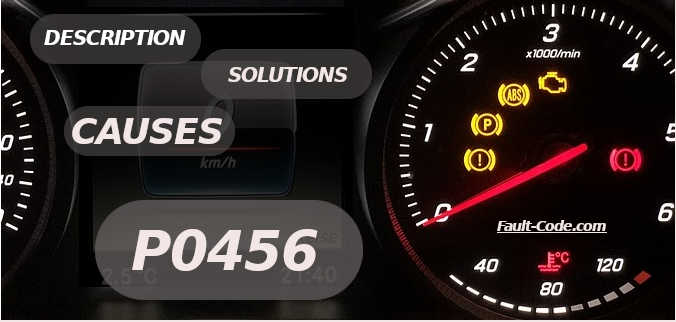Reasons for OBD2 code P0456 General
Code P0456 may have one or more of the following causes:
- A missing or loose fuel filler cap
- An incorrect fuel filler cap was used
- The fuel filler cap remains open or does not close
- Foreign bodies stuck in the fuel filler cap
- Leaks from EVAP or fuel tank
- Leaky EVAP hose
- Leaky fuel tank
P0456 Technical notes
P0456 is a very popular code because the code is set if the fuel filler cap is loose or missing. Start by tightening the filler cap and cleaning the code. In most cases, the code can be cleared by disconnecting the car battery for about 30 minutes.
What are the most common reasons for code P0456?
Depending on the year, brand and model, DTC code P0456 can have many causes. Here are some of the most common causes.
A loose or missing fuel filler cap – this is by far the most common cause for EVAP leak codes such as P0456, P0442, P0455 or P0457. Install and tighten the gas cap after each refueling.
When refuelling with the engine running – Always switch off the engine while refuelling, and not just for safety reasons. If the EVAP leakage monitor operates while the engine is idling while the fuel filler cap is removed, it will detect the leak and set the DTC code.
Defective filler cap or seal – If the filler cap is worn or the seal is broken, it does not seal properly. Likewise, some EVAP systems are more sensitive, and a non-abrasive petrol filler cap, even if it is the correct type, may not seal properly.
Locked valve – at least two solenoid valves open and close the EVAP system to direct fuel vapor to the engine. Corrosion or contamination can keep the valve open and the controller records this as a leak.
Nissan / Infiniti – Locked Ventilation Control Valve – Located near the active carbon canister, the valve is highly susceptible to corrosion and contamination. For some models, upgraded valves or an auxiliary filter kit are available.
Hyundai, Mazda, Volkswagen – The vent valve is blocked – Again, these valves are very susceptible to corrosion and contamination.
Older vehicles – With time, plastics and rubber become more fragile and less flexible. Plastic parts and rubber hoses can crack, resulting in poor sealing of the EVAP system. A smoke test may be necessary to detect less obvious cracks.
P0456 Meaning
This diagnosis detects leaks in the fuel evaporator purge line (EVAP) by means of a vacuum in the engine intake manifold. If the pressure does not increase, the engine control module (ECM) will check for leaks in the line between the fuel tank and the EVAP absorber volume control solenoid valve under the following vacuum test conditions.
The bypass valve of the vacuum shut-off valve is opened to clean the line between the fuel tank and the EVAP absorber volume control solenoid valve. The EVAP Absorber Ventilation Control Valve will then be closed to cut off the EVAP purge line. The EVAP absorber volume control solenoid valve is opened to lower the pressure in the EVAP purge line with the intake manifold vacuum. Once this pressure reduction has been implemented, the EVAP Absorber Filter Volume Control Valve is closed.












